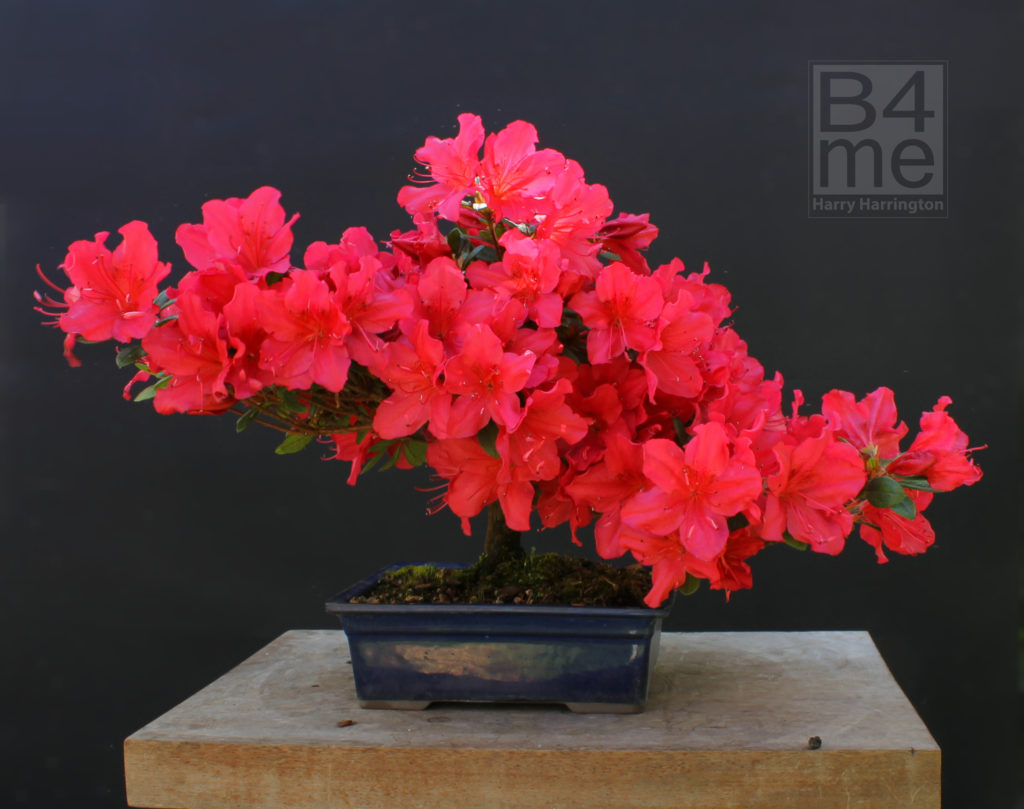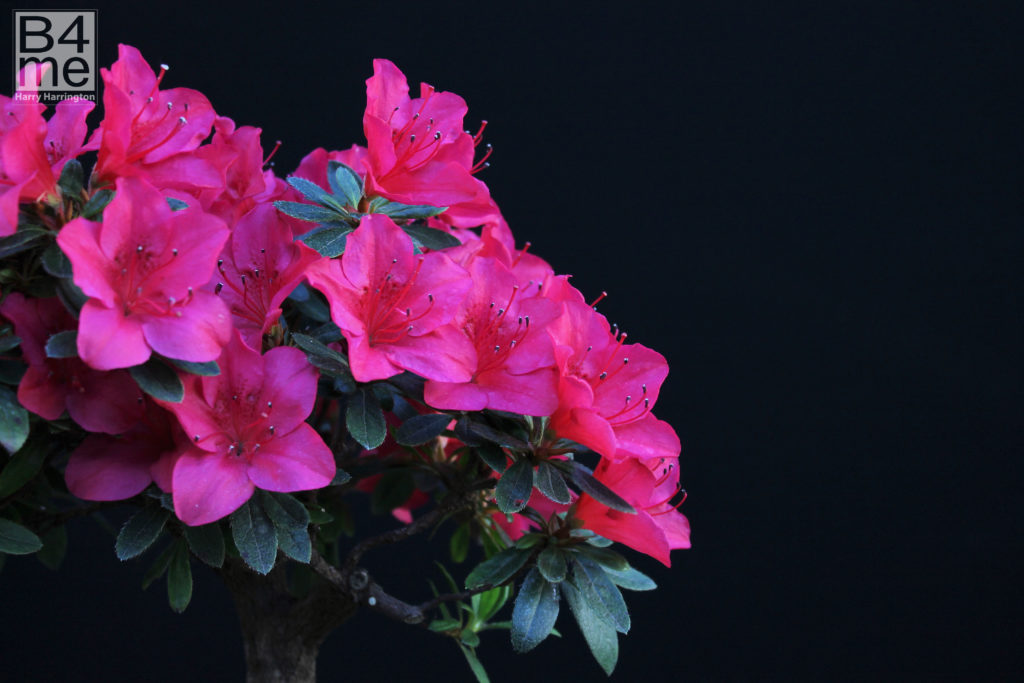The Rhododendron genus is massive and includes anything between 500-900 species depending on which authority you consider. Some species are so similar to others that they are listed as subspecies rather than distinct species in their own right, others are established hybrids (such as Kurume and Satsuki) that are sometimes regarded as species in their own right.

Rhododendrons are deciduous or evergreen trees and shrubs from Australasia, N America, SW China, Tibet, Burma, N India and New Guinea. They occur in many diverse habits, from dense forest to alpine tundra, and from sea-level to high altitude. They vary greatly in habit, some can reach heights of 25 metres whilst others creep at ground-level to form prostrate shrubs.
All Rhododendron and Azalea species have lance-shaped mid- to dark-green leaves ranging in size from 4mm to 75 cm long. They are mainly grown as bonsai for their spectacular flowers that are usually borne singly or in clusters in Spring (there are also a number of species that flower in Autumn/Winter and Summer).
Flowers can vary greatly in size and shape across the genus but all are usually 5-lobed and often marked with flares and spots on the inside.
In terms of bonsai, it is small-leaved species that are suitable; these tend to be Azaleas though there is no botanical difference between Azaleas and Rhododendrons and confusingly, there are a number of small-leaved Rhododendrons that are not classed as Azalea.
The two principal Azalea species that are used for bonsai are Satsuki azaleas and Kurume azaleas though there are many other Azalea species and hybrids that are suitable and these should not be discounted as potential bonsai material. All Rhododendron species have the ability to withstand root pruning and all will back-bud with ease.
SATSUKI AZALEAS
Satsuki hybrids are Japanese-raised Azaleas bred using mainly R. indicum and R.simsii. Satsuki azaleas display a wide variety of flower colours and size, in Japan there are two or three different periodicals wholly devoted to their care and some enthusiasts will grow them exclusively.
Less hardy than most Azaleas, Satsuki have an excellent low, twiggy habit and bear funnel shaped, unscented flowers in whites,pinks, reds and purples in Summer (not Spring as is typical with many R. species).
KURUME AZALEAS
Kurume hybrids are Japanese-raised Azaleas originating from crosses between R. kaempferi (which were originally Dutch bred), R.kiusianum and R.obtusum. Kurume hybrids are hardier than Satsukis and produce numerous, very small, funnel shaped flowers in a wide range of colours in Spring.
BONSAI CULTIVATION NOTES
POSITION Rhododendrons dislike full sun and strong light can quickly fade and ruin flowers. Place in partial shade or dappled sunlight. During the summer months ensure that the bonsai pot is not subjected to full sun as Azaleas/Rhododendrons need their root systems to be kept cool. Rhododendrons have varying abilities to withstand frost, some species are able to withstand extremely low temperatures while others such as Satsukis are relatively frost-tender. Frost hardiness is very much down to individual hybrids and unless an individual specimen is known to be hardy to a certain temperature, it is worth providing good frost protection as soon as Winter arrives. Place under glass outside but do not bring indoors.
Frost damage is most likely to effect top growth as Rhododendrons have relatively frost hardy roots. If frosts do cut back leaves they are usually regenerated the following season.
WATERING In hard-water areas trees must be watered with rainwater only to avoid lime deposits building up in the soil. Though not preferable, if hard water has to be used on occasions, the pH value of the compost can be adjusted by applying white vinegar to water ONCE a month. Mix at a rate of 1 tablespoon to a gallon of water.
FEEDING Feed every two weeks in Spring until flowering, do not feed at all whilst in flower as this can result in loss of flowers and flower buds at the expense of leaf growth. After flowering has finished, feed once a month with a fertiliser intended for acid-loving/lime-hating plants.
REPOTTING Repot as soon as flowering has finished annually or when roots fill pot. A lime-free soil mix MUST be used. I would strongly suggest Japanese Kanuma bonsai soil, but mix it 50/50 with a volcanic soil such as pumice to stop the inevitable breakdown of the Kanuma.
PRUNING Azaleas/Rhododendrons are basally dominant which means they grow more strongly at the base and sides than at the top; for this reason (unlike most other species used for bonsai) they should be pruned much harder at the bottom and sides than the top.
Azaleas respond well to hard pruning and if pruned back to a stump after flowering will bud-back prolifically (assuming good health). This should never be carried out two years running though. For maintenance purposes, deadhead all flowers as they fade and then prune /pinch out secondary branches until mid-Summer.
PROPAGATION From softwood cuttings in early Summer, air-layering/ground layering in early Summer after flowering has finished.
PESTS AND DISEASES Whiteflies, scale insects, caterpillars, aphids, mildew, budblast, rust, leaf gall, petal blight and lime-induced chlorosis (if soil not acidic enough). Never spray open flowers with insecticides or fungicides as this will cause them to wilt and fall.
STYLING Suitable for all forms except formal broom in all sizes. Small-leaved and small-flowered varieties are preferred for smaller sizes. Generally, the larger the flower size the larger the tree needs to be.
Azaleas flower prolifically and the tree itself can become completely obscured, many enthusiasts remove pockets of buds around the tree to allow areas of fresh green leaves to be seen as a relief from the mass of colour.

Azalea flowers in June.

